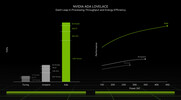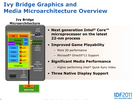NVIDIA RTX 4000 Ada Generation Laptop GPU vs Intel HD Graphics 4000
NVIDIA RTX 4000 Ada Generation Laptop GPU
► remove from comparison
The Nvidia RTX 4000 Ada Generation, not to be confused with the A4000, P4000 or RTX 4000 Turing Generation, is a very powerful professional graphics card for use in laptops that sports 7,424 CUDA cores and 12 GB of ECC GDDR6 VRAM. Brought into existence in 2023, this graphics adapter leverages TSMC's 5 nm process and Nvidia's Ada Lovelace architecture to achieve great performance combined with moderate power consumption. The Nvidia-recommended TGP range for the card is very wide at 60 W to 175 W leading to bizarre performance differences between different systems powered by what is supposed to be the same product.
Hardware-wise, the RTX 4000 is a GeForce RTX 4080 Laptop in disguise. Consequently, both make use of the AD103 chip and have little difficulty running triple-A games at QHD 1440p.
Quadro series graphics cards ship with much different BIOS and drivers than GeForce cards and are targeted at professional users rather than gamers. Commercial product design, large-scale calculations, simulation, data mining, 24 x 7 operation - if any of this sounds familiar, then a Quadro card will make you happy.
Architecture and Features
Ada Lovelace brings a range of improvements over older graphics cards utilizing the outgoing Ampere architecture. It's not just a better manufacturing process and a higher number of CUDA cores that we have here (up to 16,384 versus 10,752); under-the-hood refinements are plentiful, including an immensely larger L2 cache and an optimized ray tracing routine (a different way to determine what is transparent and what isn't is used) and other changes. Naturally, these graphics cards can both encode and decode some of the most widely used video codecs, AVC, HEVC and AV1 included; they also support a host of Nvidia technologies, including Optimus and DLSS 3, and they can certainly be used for various AI tasks.
The RTX 4000 features 58 RT cores of the 3rd generation, 232 Tensor cores of the 4th generation and 7,424 CUDA cores, making it a lot faster than the RTX 3500 Ada Generation. Elsewhere, the graphics card comes with 12 GB of 192-bit wide ECC GDDR6 memory for a very healthy throughput of ~432 GB/s. Error correction can be turned off if desired. The fact that error correction is present here proves that the RTX 4000 is indeed targeted at professional users.
Just like Ampere-based cards, the RTX 4000 makes use of the PCI-Express 4 protocol. 8K SUHD monitors are supported, however DP 1.4a video outputs can potentially prove to be a bottleneck down the line.
Performance
With its power target set to ~130 W, the Ada Generation graphics card delivers a Blender Classroom v3.3 CUDA score of 22 seconds which is a very good result. All 2024 games are playable at 1440p with the highest settings possible on this GPU.
Nvidia's marketing materials mention "up to 33.5 TFLOPS" of performance which is pretty impressive. The RTX 5000 Ada Generation is good for a little over 42 TFLOPS, for reference.
Your mileage may vary depending on how competent the cooling solution of your laptop is and how high the TGP power target of the RTX 4000 is. One other thing worth mentioning is that enabling error correction appears to reduce the amount of video memory that is available to applications and games by up to a gigabyte.
Power consumption
Nvidia no longer divides its laptop graphics cards into Max-Q and non-max-Q models. Instead, laptop makers are free to set the TGP according to their needs, and the range can sometimes be shockingly wide. This is the case with the RTX 4000, as the lowest value recommended for it sits at just 60 W while the highest is more than two times higher at 175 W (this most likely includes Dynamic Boost). The slowest system built around an RTX 4000 Ada can easily be 60% slower than the fastest one. This is the kind of delta that we've already seen on consumer-grade laptops featuring the latest GeForce RTX cards.
Last but not the least, the improved 5 nm process (TSMC 4N) the RTX 4000 Ada is built with makes for very decent energy efficiency, as of mid 2023.
Intel HD Graphics 4000
► remove from comparison
The Intel HD Graphics 4000 (GT2) is a processor graphics card that is included in the Ivy Bridge processors of 2012 (3rd generation of core, e.g. Core i7-3770). The base clock can be automatically overclocked using Turbo Boost technology. Depending on the processor model, the base and turbo clock rate may differ greatly resulting in different graphics performance of ULV parts compared to high-end desktop and laptop quad-core parts.
Compared to the Intel HD Graphics 3000 in Sandy Bridge CPUs, the HD 4000 card was completely redesigned and offers improved DirectX 11 capable shaders, Hardware Tessellation, a dedicated level 3 cache (before the Last Level Cache LLC of the CPU) and DirectCompute support. The IPC (instructions per clock) can therefore be even 2x as fast as with Sandy Bridge and overall up to 60% more performance (3DMark Vantage) should be possible.
First benchmarks position the HD Graphics 4000 (in a fast quad core desktop CPU) on a level with a dedicated Nvidia GeForce GT 330M and therefore above the AMD processor graphics Radeon HD 6620G. In our extensive tests with games the HD Graphics 4000 was able to beat the HD 6620G in a fast Core i7-3820QM by about 15%. In the slower i7-3610QM and a dual core i5 it was on a similar level as the 6620G. Therefore, casual gamers that wont mind reducing the quality settings in high end games, may be happy with the performance of the HD Graphics 4000. Beware, that the HD Graphics 4000 is used with different clock speeds depending on the CPU model. The ULV CPUs (Core ix-3xx7U) for example feature lower clock speeds and cant maintain the Turbo frequency as good as the 35 - 55 Watt models. Therefore, the ULV version is about 30% slower on average.
A speciality of the Ivy Bridge GPUs is that 4x MSAA is supported in hardware now. However, 2x is only supported through software. The algorithm to support 2x is going through the 4x pipeline with a software algorithm, so performance is similar to 4x MSAA.
The integrated video decoder called Multi Format Codec Engine (MFX) was also improved and should allow even simultaneus 4K video decoding. DXVAChecker lists MPEG2, VC1, WMV9, and H264 as supported codecs. QuickSync for fast transcoding of videos was also optimized for higher performance and better image quality.
Another new feature is the support for up to 3 independent displays (depends on how the HD 4000 is used in the laptop - maybe only with a DisplayPort / eDP) as AMD offers with theirs Eyefinity support (up to 6 displays). DisplayPort 1.1 (max 2560x1600) and HDMI 1.4 (max 1920x1080 without hacks) are supported by the chip according to Intel.
Due to the 22nm 3D Tri-Gate production process, the power consumption should be relatively low (the development was focused on performance per Watt). The TDP of the whole package (including processor and memory controller) varies between 18 Watt (ULV) up to 45 Watt (mobile quad core) for the consumer laptop CPUs.
| NVIDIA RTX 4000 Ada Generation Laptop GPU | Intel HD Graphics 4000 | |||||||||||||||||||||||||||||||||||||||||||||||||||||||||||||||||||||||||||||||||||||||||||
| HD Graphics Series |
|
| ||||||||||||||||||||||||||||||||||||||||||||||||||||||||||||||||||||||||||||||||||||||||||
| Architecture | Ada Lovelace | Gen. 7 Ivy Bridge | ||||||||||||||||||||||||||||||||||||||||||||||||||||||||||||||||||||||||||||||||||||||||||
| Pipelines | 7424 - unified | 16 - unified | ||||||||||||||||||||||||||||||||||||||||||||||||||||||||||||||||||||||||||||||||||||||||||
| Raytracing Cores | 58 | |||||||||||||||||||||||||||||||||||||||||||||||||||||||||||||||||||||||||||||||||||||||||||
| Tensor / AI Cores | 232 | |||||||||||||||||||||||||||||||||||||||||||||||||||||||||||||||||||||||||||||||||||||||||||
| Theoretical Performance | 33.6 TFLOPS FP32 | |||||||||||||||||||||||||||||||||||||||||||||||||||||||||||||||||||||||||||||||||||||||||||
| Memory Speed | 16000 effective = 2000 MHz | |||||||||||||||||||||||||||||||||||||||||||||||||||||||||||||||||||||||||||||||||||||||||||
| Memory Bus Width | 192 Bit | 64/128 Bit | ||||||||||||||||||||||||||||||||||||||||||||||||||||||||||||||||||||||||||||||||||||||||||
| Memory Type | GDDR6 | |||||||||||||||||||||||||||||||||||||||||||||||||||||||||||||||||||||||||||||||||||||||||||
| Max. Amount of Memory | 12 GB | |||||||||||||||||||||||||||||||||||||||||||||||||||||||||||||||||||||||||||||||||||||||||||
| Shared Memory | no | yes | ||||||||||||||||||||||||||||||||||||||||||||||||||||||||||||||||||||||||||||||||||||||||||
| Memory Bandwidth | 432 GB/s | |||||||||||||||||||||||||||||||||||||||||||||||||||||||||||||||||||||||||||||||||||||||||||
| API | DirectX 12 Ultimate, Shader 6.7, OpenGL 4.6, OpenCL 3.0, Vulkan 1.3 | DirectX 11, Shader 5.0, OpenGL 3.1 | ||||||||||||||||||||||||||||||||||||||||||||||||||||||||||||||||||||||||||||||||||||||||||
| Power Consumption | 150 Watt (60 - 150 Watt TGP) | |||||||||||||||||||||||||||||||||||||||||||||||||||||||||||||||||||||||||||||||||||||||||||
| technology | 5 nm | 22 nm | ||||||||||||||||||||||||||||||||||||||||||||||||||||||||||||||||||||||||||||||||||||||||||
| PCIe | 4.0 x16 | |||||||||||||||||||||||||||||||||||||||||||||||||||||||||||||||||||||||||||||||||||||||||||
| Displays | 4 Displays (max.), HDMI 2.1, DisplayPort 1.4a | |||||||||||||||||||||||||||||||||||||||||||||||||||||||||||||||||||||||||||||||||||||||||||
| Notebook Size | large | |||||||||||||||||||||||||||||||||||||||||||||||||||||||||||||||||||||||||||||||||||||||||||
| Date of Announcement | 21.03.2023 | 23.03.2011 | ||||||||||||||||||||||||||||||||||||||||||||||||||||||||||||||||||||||||||||||||||||||||||
| Link to Manufacturer Page | images.nvidia.com | |||||||||||||||||||||||||||||||||||||||||||||||||||||||||||||||||||||||||||||||||||||||||||
| Predecessor | RTX A3000 Laptop GPU | |||||||||||||||||||||||||||||||||||||||||||||||||||||||||||||||||||||||||||||||||||||||||||
| Codename | Ivy Bridge | |||||||||||||||||||||||||||||||||||||||||||||||||||||||||||||||||||||||||||||||||||||||||||
| Core Speed | 350 - 1350 (Boost) MHz | |||||||||||||||||||||||||||||||||||||||||||||||||||||||||||||||||||||||||||||||||||||||||||
| Features | QuickSync |
| |||||||||||||||||||||||||
Benchmarks
3DM Vant. Perf. total + Intel HD Graphics 4000
specvp11 snx-01 + Intel HD Graphics 4000
specvp12 sw-03 + NVIDIA RTX 4000 Ada Generation Laptop GPU
Cinebench R15 OpenGL 64 Bit + NVIDIA RTX 4000 Ada Generation Laptop GPU
GFXBench T-Rex HD Offscreen C24Z16 + Intel HD Graphics 4000
Average Benchmarks NVIDIA RTX 4000 Ada Generation Laptop GPU → 100% n=8
Average Benchmarks Intel HD Graphics 4000 → 6% n=8
* Smaller numbers mean a higher performance
1 This benchmark is not used for the average calculation
Game Benchmarks
The following benchmarks stem from our benchmarks of review laptops. The performance depends on the used graphics memory, clock rate, processor, system settings, drivers, and operating systems. So the results don't have to be representative for all laptops with this GPU. For detailed information on the benchmark results, click on the fps number.

Baldur's Gate 3
2023
F1 22
2022
Far Cry 5
2018
X-Plane 11.11
2018
Team Fortress 2
2017
Farming Simulator 17
2016
FIFA 16
2015
World of Warships
2015
Metal Gear Solid V
2015
Dota 2 Reborn
2015
Dirt Rally
2015
GTA V
2015
Battlefield Hardline
2015
F1 2014
2014
The Evil Within
2014
Ryse: Son of Rome
2014
Alien: Isolation
2014
Fifa 15
2014
Risen 3: Titan Lords
2014
GRID: Autosport
2014
Watch Dogs
2014
Titanfall
2014
Thief
2014
X-Plane 10.25
2013
Call of Duty: Ghosts
2013
Battlefield 4
2013
F1 2013
2013
Fifa 14
2013
Total War: Rome II
2013
Saints Row IV
2013
Company of Heroes 2
2013
Metro: Last Light
2013
BioShock Infinite
2013
SimCity
2013
Tomb Raider
2013
Crysis 3
2013
Dead Space 3
2013
Far Cry 3
2012
Assassin´s Creed III
2012
Hitman: Absolution
2012
Dishonored
2012
World of Tanks v8
2012
Fifa 13
2012
F1 2012
2012
Borderlands 2
2012
Guild Wars 2
2012
Counter-Strike: GO
2012
Darksiders II
2012
Sleeping Dogs
2012
The Secret World
2012
Max Payne 3
2012
Dirt Showdown
2012
Diablo III
2012
Risen 2: Dark Waters
2012
Mass Effect 3
2012
Alan Wake
2012
Anno 2070
2011
Battlefield 3
2011
Batman: Arkham City
2011
Fifa 12
2011
F1 2011
2011
Dirt 3
2011
Crysis 2
2011
Mafia 2
2010
StarCraft 2
2010
Metro 2033
2010Average Gaming NVIDIA RTX 4000 Ada Generation Laptop GPU → 100%
Average Gaming 30-70 fps → 100%
Average Gaming Intel HD Graphics 4000 → 22%
Average Gaming 30-70 fps → 21%
| NVIDIA RTX 4000 Ada Generation Laptop GPU | Intel HD Graphics 4000 | |||||||||||||
|---|---|---|---|---|---|---|---|---|---|---|---|---|---|---|
| low | med. | high | ultra | QHD | 4K | low | med. | high | ultra | QHD | 4K | |||
| Cyberpunk 2077 2.2 Phantom Liberty | 129.3 | 115.1 | 108.4 | 98.3 | 68.5 | |||||||||
| Baldur's Gate 3 | 178.3 | 160.6 | 141.6 | 137 | 90.7 | |||||||||
| F1 22 | 275 | 264 | 238 | 95.5 | 65.7 | |||||||||
| Tiny Tina's Wonderlands | 275.4 | 232.6 | 171.4 | 137.1 | 92 | |||||||||
| Strange Brigade | 452 | 372 | 323 | 292 | 210 | |||||||||
| Far Cry 5 | 168 | 148 | 138 | 128 | 125 | |||||||||
| X-Plane 11.11 | 166.8 | 144 | 113.1 | |||||||||||
| Final Fantasy XV Benchmark | 207 | 185.3 | 150 | 119.5 | ||||||||||
| Dota 2 Reborn | 215.4 | 189.7 | 185.2 | 164.4 | 96 | 40.2 | 16.9 | |||||||
| GTA V | 185.8 | 183.9 | 179.4 | 125.6 | 118.7 | 26.8 | ||||||||
| NVIDIA RTX 4000 Ada Generation Laptop GPU | Intel HD Graphics 4000 | |||||||||||||
| low | med. | high | ultra | QHD | 4K | low | med. | high | ultra | QHD | 4K | < 30 fps < 60 fps < 120 fps ≥ 120 fps | 10 | 1 9 | 2 8 | 2 6 | 6 2 | | < 30 fps < 60 fps < 120 fps ≥ 120 fps | 1 1 | 1 | 1 | | | |
For more games that might be playable and a list of all games and graphics cards visit our Gaming List




























































